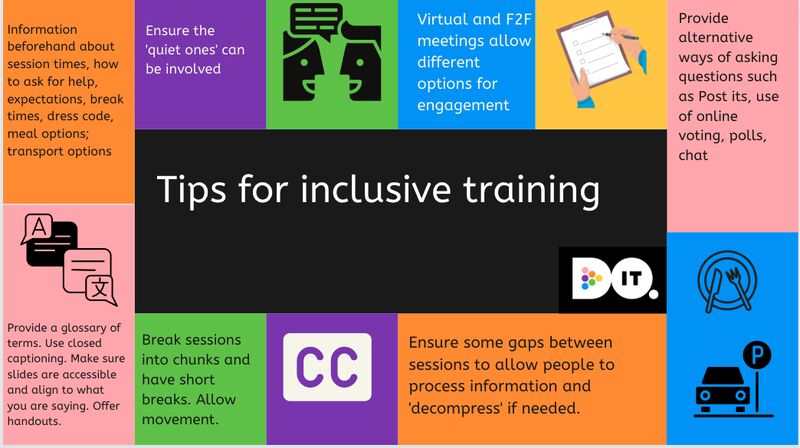'Diversity training is most effective when it’s part of an enterprise-wide strategic approach, includes both awareness and skills development, and is conducted over time' 5 Strategies to Infuse D&I into Your Organization, HBR
'One of the most common and best-studied diversity-related activities in organisations is diversity training. The overall conclusion from over 40 years of research is that the generic diversity training that many companies engage in does not have a positive impact and in some instances can promote backlash and even activate bias.19-21 Nonetheless, certain features of diversity training make it more effective for changing behaviour. Coercive approaches based on rules or blaming individuals, and
short-term approaches rarely work.21 Instead, training should be positive, long-term, and focus on behaviour change, take an active approach and promote inter-group contact.',What Really Works: Ensuring Inclusive Working Cultures Report, BITC.
Employer recommendations
➖Define what will be done differently once the learning journey is complete and how current behaviors impact experiences of inclusion (use employees surveys or focus groups or other ways of diagnosing current inclusion sentiment and understand current gaps).
➖ Prioritise specific, observable behaviours that improve inclusion then link them back to the existing organisational strategy, values, and/or competency model. McKinsey research shows a core set of practices create the experience of inclusion at individual and enterprise levels
➖Make the consistent display of inclusive behaviours a requirement to progress at the organisation
➖Consider how learning about the prioritised core inclusion practices and behaviours can be embedded into existing training programmes rather than delivered as standalone learning modules. This will promote that inclusivity skills and behaviours are an extension of the current structure, not “extra” work. For example, inclusive behaviours can be incorporated into how values are evaluated during performance reviews.
➖Run regular internal communications campaigns to continuosly educate and embed the importance of inclusive behaviours. There are many free resources that can be downloaded to any organisation to use internally such as Meta's 'Be the Ally' campaign materials.
➖Be creative to increase optional attendance for workshops by using leadership role modeling, a continuous communications plan reiterating a compelling value proposition, and an “opt-out” registration process. The goal should be to create a program where individuals are compelled to attend but invited to participate rather than pushed into it. Don't require everyone to attend mandatory, non-tailored training sessions - these become a tick box exercise with attendance as the success metric and participants who feel forced to engage on DE&I topics may feel resentful. Evaluate success based on post-session impact and measurable behaviour change, not just number of attendees.
➖Invite employees into a conversation to explore how change may benefit not just others but their own experience as well. Avoid telling employees they need to change.
➖Opt for shorter, more frequent sessions to sustain momentum without overwhelming the audience. Avoid long sessions focused on statistics with little interaction or limited time for reflection and practice. For further recommendations on evidence based behavioural change mechanisms, refer to pages 10 -14 in What Really Works: Ensuring Inclusive Working Cultures Report, BITC.
➖Ensure training is inclusive and engaging. In the image below, Professor Amanda Kirby, a neurodiversity specialist, has recommended ways to make training sessions more inclusive, encouraging everyone to be able to engage.

➖Meet employees where they are in their individual D&I journeys with space to reflect, discuss, and practice in small groups.
➖Ensure facilitators are knowledgeable about D&I, willing to authentically share their own experiences, and able to create a safe space for vulnerable reflections. Discussing equity and inclusion (or a lack thereof) can be complex, raising deeply entrenched mindsets around power, privilege, and the status quo, and the conversations required can often be uncomfortable.
➖Educate learners about the difference between equality and equity and why the organisation is striving for equity rather than equality. 'Equality is giving everyone a shoe; equity is giving everyone a shoe that fits', Naheed Dosani.
Further information
- Article: How to make diversity training more effective, d&i Leaders
- Article: Don’t train your employees on DE&I. Build their capabilities, McKinsey
- Report: What Really Works: Ensuring Inclusive Working Cultures, BITC
- Article: 5 Strategies to Infuse D&I into Your Organization, HBR
- Article: Why Unconscious Bias Training Doesn’t Work—5 Ways to Actually Make a Difference, Greg Lewis
